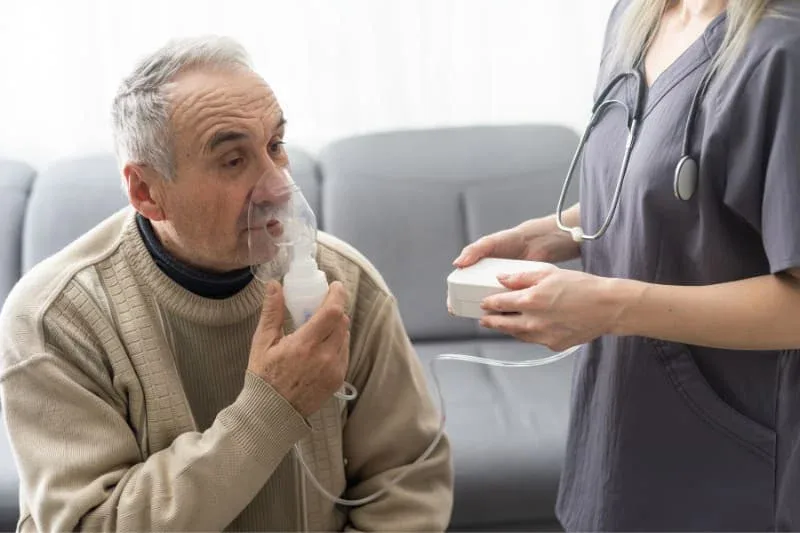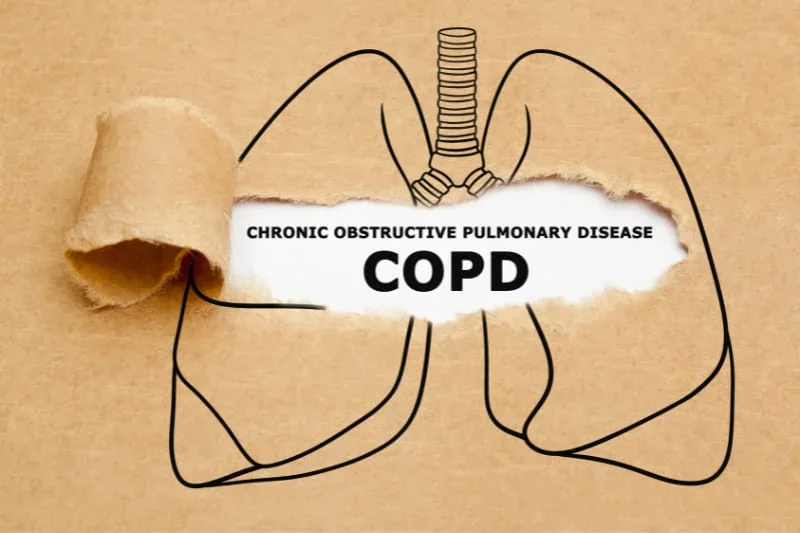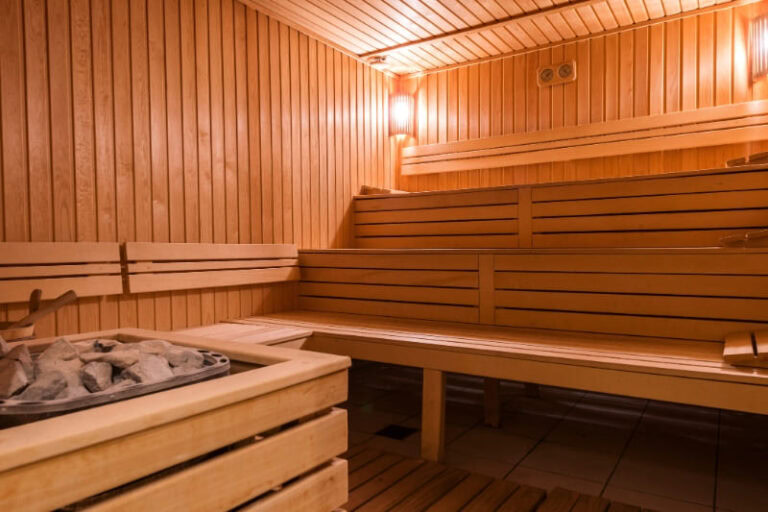Sauna Therapy for COPD and Emphysema: Respiratory Guide

Millions of people fight for air every day, trying everything from inhalers to oxygen therapy. But there’s a simple treatment gaining attention that might help you breathe easier – sauna therapy. Scientists have found that regular sauna sessions might actually open up airways, reduce inflammation, and make breathing less of a battle.
Key Takeaways
- Sauna therapy might help people with COPD and emphysema breathe better
- Research shows saunas may improve lung function and reduce airway blockage
- People who use saunas 3-4 times weekly might have a lower risk of lung problems
- Always talk to your doctor before trying sauna therapy with COPD
- Start with short, gentle sessions and stop if breathing gets worse
Real studies show that people who use saunas regularly have better lung function and may even lower their risk of breathing problems getting worse. While it won’t cure COPD, this drug-free option might be worth adding to your treatment plan.
Let’s look at what science really says about saunas for lung health and how you might safely try it yourself.
Table of Contents
MEDICAL DISCLAIMER: The information provided in this article is for educational purposes only and is not intended as medical advice. Always consult with a qualified healthcare professional before starting any new health regimen, including the use of saunas.
What Are COPD and Emphysema?
COPD stands for Chronic Obstructive Pulmonary Disease. It makes it hard to breathe. Emphysema is a type of COPD where the tiny air sacs in your lungs get damaged.
About 212 million people worldwide have COPD. It was the third leading cause of death globally in 2019. 1[https://www.ncbi.nlm.nih.gov/books/NBK482217/]
What causes these conditions? Smoking cigarettes is the main cause. Up to 75% of people with COPD currently smoke or used to smoke. Other causes include breathing polluted air for many years, working around dust and chemicals, and some genetic problems.
Doctors usually treat COPD with medicines that open airways and reduce swelling. Many patients need breathing exercises, and those with severe cases may need oxygen. While these treatments help manage symptoms, they don’t cure the disease. That’s why many people look for extra help like sauna therapy.
Why People With COPD Are Asking About Saunas
If you have COPD or emphysema, you know the daily struggle. Simple tasks like walking up stairs or carrying groceries can leave you gasping for air. The constant coughing, the tiredness that never goes away, and the worry about your next flare-up can really affect your quality of life.
Many people with COPD say they feel trapped by their condition. Standard treatments help, but they don’t always do enough. That’s why many people look for extra ways to feel better beyond their regular medicine.
Sauna therapy is getting more attention as a possible way to help ease COPD symptoms. It’s not new—people have used heat therapy for health for thousands of years—but now science is starting to back up what many have experienced: that regular sauna sessions might actually help your lungs work better.
What Science Says About Saunas for Lung Health
Better Breathing and Lung Function
Scientists have studied how saunas might help people with breathing problems.
A 2014 study tested “Waon therapy” (a type of sauna) on COPD patients. People sat in a 60°C (140°F) sauna for 15 minutes, followed by 30 minutes of rest under warm blankets. They did this for 4 weeks. Results showed big improvements in how much air they could breathe out. This means less airway blockage. 2
Another study from 2008 showed that COPD patients who used sauna therapy had better heart function and less pressure in their lung blood vessels during exercise. These patients could exercise longer and reported feeling better overall. 3
The researchers found that after just 4 weeks of daily sauna sessions, patients could breathe more easily during physical activity. Their quality of life scores also went up, showing that the benefits weren’t just physical but also improved how they felt day to day.
Lower Risk of Breathing Problems
A major long-term study followed 1,935 men for over 25 years. The results were eye-opening. Men who used saunas 2-3 times weekly had 27% less risk of getting lung diseases (including COPD) compared to men who used saunas once a week or less. 4
Even more impressive, men who used saunas 4 or more times weekly had their risk drop by 41%! This suggests that regular sauna use might help protect against developing these conditions in the first place.
A newer study in 2023 specifically looked at COPD risk. It found that using saunas 3-7 times weekly might lower the chance of getting COPD. 5
This research supports what the earlier studies had found and adds more weight to the idea that saunas could play a role in lung health.

How Saunas Might Help Your Lungs
Scientists think saunas might help your lungs in several key ways:
The heat from saunas may lower inflammation in your airways. When your airways are less inflamed, it’s easier to breathe. Research shows that heat exposure activates heat shock proteins, which help reduce inflammation throughout the body, including the respiratory system. 6
The warm environment can improve blood flow to the muscles that help you breathe. When these muscles get better blood flow, they work more efficiently, making breathing less work.
Though it seems odd, sauna air can actually add moisture to the mucus in your airways. A study in the American Journal of Medicine explains that despite the “dry” air, saunas can hydrate respiratory tract mucus. This makes it easier to clear mucus from your lungs. 7
Regular sauna use improves heart function, which means better oxygen delivery throughout your body. For people with COPD who often struggle with low oxygen levels, this could be very helpful.
The 2008 study mentioned earlier found that sauna therapy lowered the pressure in lung blood vessels during exercise. (Umehara et al., 2008) High pressure in these vessels makes breathing during activity much harder, so reducing this pressure could help you be more active.
Different Types of Saunas for People With COPD
Not all saunas are the same. Here are the main types that might help with COPD symptoms:
Finnish Sauna
This is what most people think of as a “regular” sauna. It’s very hot (176-212°F or 80-100°C) with low humidity (10-20%). While effective for many health benefits, this high heat might be too intense for some people with severe breathing problems.
Waon Therapy
This gentler heat therapy was specifically designed for people with health conditions. It uses infrared saunas at lower temperatures (about 140°F or 60°C) followed by rest under blankets. Most of the COPD studies used this type of therapy. (Kikuchi et al., 2014)
Infrared Sauna
These run cooler (122-140°F or 50-60°C) but heat your body directly rather than heating the air around you. The lower temperature might make infrared saunas more comfortable for people with breathing problems.
For people with COPD, the gentler heat of Waon therapy or infrared saunas is often recommended as a starting point. The lower temperature makes it easier to breathe while still providing potential benefits.
How to Use a Sauna Safely With COPD or Emphysema
What Studies Suggest Works Best
Based on research showing good results, here’s what seems to work best for people with COPD:
- Heat level: Around 140°F (60°C) – this is cooler than regular saunas and more comfortable for breathing
- Session time: 15 minutes in the sauna, then 30 minutes of rest with warm blankets to continue the therapeutic effect
- Frequency: 3-5 times weekly for consistent benefits
- Program length: At least 4 weeks to start seeing improvements
- Hydration: Drink water before and after to replace fluids lost from sweating
This protocol comes directly from the studies that showed positive results for COPD patients. (Kikuchi et al., 2014)

Safety First!
While sauna therapy shows promise, safety must come first when you have a condition like COPD:
- Talk to Your Doctor: Get approval from your doctor before trying sauna therapy, especially if you have heart problems alongside COPD.
- Start Small: Begin with just 5-10 minutes at lower temperatures. You can slowly work up to longer sessions as your body gets used to the heat.
- Watch for Warning Signs: Get out of the sauna right away if you notice:
- More shortness of breath than usual
- Wheezing gets worse
- Any chest pain
- Feeling dizzy or lightheaded
- Extreme tiredness
- Skip the Alcohol: Never use saunas after drinking alcohol. This can increase your risk of dehydration and cause dangerous drops in blood pressure.
- Stay Hydrated: Drink plenty of water before, after, and if needed, during your sauna session.
- Check Your Meds: Ask your doctor if any of your medications might affect how your body handles heat.
- Not During Flare-ups: Don’t use saunas if you’re having a COPD exacerbation or if you have a respiratory infection. Wait until you’re back to your baseline.
Who Should Avoid Saunas
Saunas aren’t safe for everyone with COPD. Even though they might help some people, they can be dangerous for others.
A 2001 study in the American Journal of Medicine highlighted these safety concerns, noting that while saunas have potential benefits, they’re not appropriate for everyone. 8 So, you should skip the sauna if you have:
- Recent heart attack or ongoing chest pain (angina)
- Heart valve problems, especially severe aortic stenosis
- High blood pressure that’s not well-controlled
- Current COPD flare-up or exacerbation
- Fever from any cause
- Pregnancy (especially in the early stages)
- Any condition that affects your ability to sweat properly
Final Verdict: Sauna Therapy for COPD and Emphysema
The science speaks for itself: sauna therapy shows real promise for people with COPD and emphysema. While not a cure, the research points to improved breathing, less airway blockage, and easier exercise for many users. The key is finding what works for your body.
Always talk with your doctor before starting, especially if you have heart issues alongside your lung condition. Begin with gentle sessions (5-10 minutes at lower temperatures), and pay attention to how your body responds.
What matters most is safety and consistency. By adding sauna therapy to your regular treatment plan, you might breathe easier and enjoy a better quality of life with your COPD or emphysema.
Just remember – this is an extra tool in your toolkit, not a replacement for your prescribed treatments.
References
- Adeloye, D., Song, P., Zhu, Y., Campbell, H., Sheikh, A., Rudan, I., & NIHR RESPIRE Global Respiratory Health Unit (2022). Global, regional, and national prevalence of, and risk factors for, chronic obstructive pulmonary disease (COPD) in 2019: a systematic review and modelling analysis. The Lancet. Respiratory medicine, 10(5), 447–458. https://doi.org/10.1016/S2213-2600(21)00511-7 ↩︎
- Kikuchi, H., Shiozawa, N., Takata, S., Ashida, K., & Mitsunobu, F. (2014). Effect of repeated Waon therapy on exercise tolerance and pulmonary function in patients with chronic obstructive pulmonary disease: a pilot controlled clinical trial. International journal of chronic obstructive pulmonary disease, 9, 9–15. https://doi.org/10.2147/COPD.S50860 ↩︎
- Umehara, M., Yamaguchi, A., Itakura, S., Suenaga, M., Sakaki, Y., Nakashiki, K., Miyata, M., & Tei, C. (2008). Repeated waon therapy improves pulmonary hypertension during exercise in patients with severe chronic obstructive pulmonary disease. Journal of cardiology, 51(2), 106–113. https://doi.org/10.1016/j.jjcc.2008.01.004 ↩︎
- Kunutsor, S. K., Laukkanen, T., & Laukkanen, J. A. (2017). Sauna bathing reduces the risk of respiratory diseases: a long-term prospective cohort study. European journal of epidemiology, 32(12), 1107–1111. https://doi.org/10.1007/s10654-017-0311-6 ↩︎
- Kunutsor, S. K., & Laukkanen, J. A. (2023). Frequent sauna bathing may reduce chronic obstructive pulmonary disease risk: A prospective study. European journal of clinical investigation, 53(5), e13940. https://doi.org/10.1111/eci.13940 ↩︎
- Fedorchenko, Y., Fedorchenko, M., Yessirkepov, M., & Bekaryssova, D. (2025). Sauna therapy in rheumatic diseases: mechanisms, potential benefits, and cautions. Rheumatology international, 45(5), 94. https://doi.org/10.1007/s00296-025-05852-0 ↩︎
- Greco, F. A. (2021). How does sauna bathing improve respiratory tract function? The American Journal of Medicine, 134(10), e541. https://doi.org/10.1016/j.amjmed.2020.11.032 ↩︎
- Hannuksela, M. L., & Ellahham, S. (2001). Benefits and risks of sauna bathing. The American journal of medicine, 110(2), 118–126. https://doi.org/10.1016/s0002-9343(00)00671-9 ↩︎

“Become a Sauna Expert Overnight!”
Grab Your “FREE” Sauna E-book NOW!
Get your hands on the ultimate sauna manual. From history to DIY setups, our free guide has it all.

As a Chartered Accountant turned sauna enthusiast, I bring a unique blend of analytical skills and hands-on experience to the world of heat therapy. With over a decade dedicated to researching and testing sauna products and practices, I’ve developed a deep understanding of this field. A the founder of HomeInDepth.com, I provide reliable, easy-to-understand information on all aspects of saunas. My goal is to guide you through every step of your sauna journey, offering meticulously researched, unbiased advice to help you make informed decisions and create your perfect sauna experience. I’m always happy to hear from sauna lovers like you—feel free to leave questions or share your own tips in the comments below so we can learn together. Contact me on:






